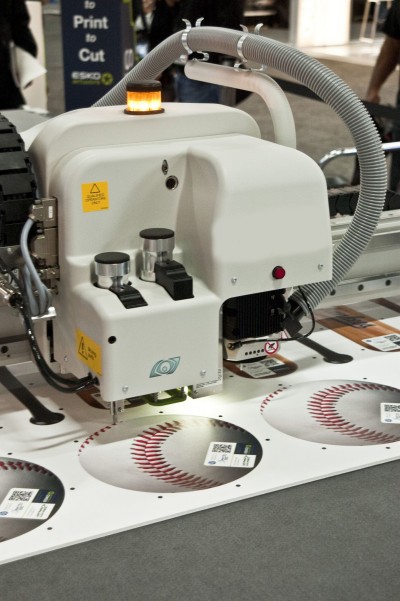Cutting paths
Finishing mistakes are costly, with expensive printed boards tossed away. So, a print shop needs to prevent front-to-back graphic misregistration, as well as compensate for any errors in print or media registration when the graphic reaches the cutting table. A good workflow will provide communications to co-ordinate what the printer prints and what the cutter cuts.
Any time a graphic is to be cut on the table, it needs to come with instructions for how this will be done. In its simplest form, a cutting path can be generated in the original graphic design software, e.g. Adobe Illustrator—but if the cutting system is complex, a lot more can be accomplished within the workflow. Clients cannot be expected to ‘tile’ a job or prepare irregular shapes properly.
In some cases, a new cutting path needs to be added, because the original path is either not present or of poor quality. Many clients do not add ‘bleeds’ to the edges of their artwork, for example, which could result in the colour of the substrate showing through if there are any distortions in the print.
A good workflow can quickly create a cutting path, offer options to clean or smooth out the edges, automatically create bleeds and tile both regular and irregular shapes.
Further, a cutting workflow with layout programming capabilities can help save on substrate material costs, as it will efficiently gang artwork together on a sheet, through a process called ‘nesting,’ to reduce wasted space and get the most use out of each sheet. Specialized software can analyze various rectangles, irregular shapes, double-sided jobs and oversized graphics and then determine the most cost-efficient layout.
If multiple images can be nested efficiently on a single piece of material, it may well mean good-sized pieces are saved to be used for future jobs. If not, the cuts are still programmed to ensure waste is minimized.
There is also the question of optimizing time, as nesting artwork efficiently means there are fewer boards to be printed and cut, so both the printer and cutting table are less taxed.
Vision control
The next step in the workflow is for the software to work seamlessly with the vision control system on the finishing table to ensure all contoured pieces are cut cleanly, even if they have been placed off-kilter. Cutting has become quite complex, requiring an awareness of the substrate and the appropriate tools to get the job done.
Vision control is necessary for digital finishing systems because all printed graphic materials entail distortions in size, rotation and scaling that could lead to inaccurate die cutting if not corrected. This capability is even more crucial for difficult contour cuts.
Some digital systems can creatively decrease the number of registration marks read from a sheet throughout the finishing process, so as to reduce the amount of time needed to cut the sheet, without sacrificing accuracy.
The finishing specifications are based on cutting ‘keys’ that supply optimized tool settings, preset parameters and blade and bit recommendations for table operators, which makes the finishing setup easier by simplifying the various tasks involved for each unique job. In many cases, setup is virtually eliminated.
Continued automation
Workflow automation is introduced to eliminate manual steps from print shops’ production processes; it is particularly helpful for repetitive tasks that can be charted out easily and do not need the personal attention of a human operator.
The trend lends itself to standardization, whereby these shops use the same setups and parameters for each file. This way, less human interference can mean a reduction of errors.
That said, messages can also be automatically sent to keep print shop staff aware of where a specific job is within the production process. Automation can even help deliver proofs to print buyers for approval.
So, while many shop owners have in the past considered their digital printers the primary limiting factor dictating production output, there are many ways they can expand their facilities’ capabilities, whether it involves installing an in-house finishing system or implementing a more effective workflow. These changes can in turn lead to increased demand for more profitable work.
Bill Hartman is vice-president (VP) of digital finishing business development for Esko, which provides pre-press and finishing software and hardware. For more information, visit www.esko.com.






